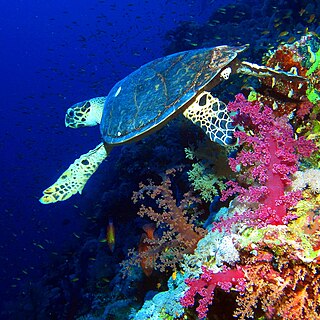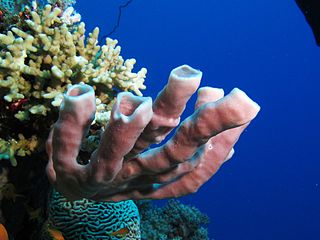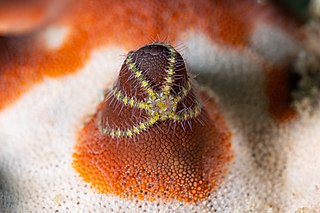
Cnidaria is a phylum under kingdom Animalia containing over 11,000 species of aquatic animals found both in fresh water and marine environments, including jellyfish, hydroids, sea anemones, corals and some of the smallest marine parasites. Their distinguishing features are a decentralized nervous system distributed throughout a gelatinous body and the presence of cnidocytes or cnidoblasts, specialized cells with ejectable flagella used mainly for envenomation and capturing prey. Their bodies consist of mesoglea, a non-living, jelly-like substance, sandwiched between two layers of epithelium that are mostly one cell thick. Cnidarians are also some of the only animals that can reproduce both sexually and asexually.

Sponges or sea sponges are members of the metazoan phylum Porifera, a basal animal clade and a sister taxon of the diploblasts. They are sessile filter feeders that are bound to the seabed, and are one of the most ancient members of macrobenthos, with many historical species being important reef-building organisms.

Demosponges (Demospongiae) are the most diverse class in the phylum Porifera. They include greater than 90% of all species of sponges with nearly 8,800 species worldwide. They are sponges with a soft body that covers a hard, often massive skeleton made of calcium carbonate, either aragonite or calcite. They are predominantly leuconoid in structure. Their "skeletons" are made of spicules consisting of fibers of the protein spongin, the mineral silica, or both. Where spicules of silica are present, they have a different shape from those in the otherwise similar glass sponges. Some species, in particular from the Antarctic, obtain the silica for spicule building from the ingestion of siliceous diatoms.

Cliona celata, occasionally called the boring sponge, is a species of demosponge belonging the family Clionaidae. It is found worldwide. This sponge bores round holes up to 5 millimetres (0.20 in) in diameter in limestone or the shells of molluscs, especially oysters. The sponge itself is often visible as a rather featureless yellow or orange lump at the bottom of the hole.

A spongivore is an animal anatomically and physiologically adapted to eating animals of the phylum Porifera, commonly called sea sponges, for the main component of its diet. As a result of their diet, spongivore animals like the hawksbill turtle have developed sharp, narrow bird-like beak that allows them to reach within crevices on the reef to obtain sponges.
Arturia canariensis, commonly known as the yellow calcareous sponge, is a species of sponge in the family Clathrinidae. It is found in shallow seas in the Canary Islands, Cape Verde, the Adriatic Sea and the Caribbean Sea. The specific epithet "canariensis" was given to this species because it was first described from Lanzarote in the Canary Islands.

Clathrina coriacea is a species of calcareous sponge belonging to the class Calcarea and family Clathrinidae. Species in the genus Clathrina are composed of calcium carbonate tube-like skeletons containing spicules. The sponge can be located in shallow waters widely distributed along North Atlantic coasts, as well as on other coasts.

Spongilla lacustris is a species of freshwater sponge from the family Spongillidae. It inhabits freshwater rivers and lakes, often growing under logs or rocks. Lacustris is a Latin word meaning "related to or associated with lakes". The species ranges from North America to Europe and Asia. It is the most common freshwater sponge in central Europe. It is the most widespread sponge in Northern Britain, and is one of the most common species of sponges in lakes and canals. Spongilla lacustris have the ability to reproduce both sexually and asexually. They become dormant during winter. The growth form ranges from encrusting, to digitate, to branched, depending upon the quality of the habitat.

Spongia officinalis, better known as a variety of bath sponge, is a commercially used sea sponge. Individuals grow in large lobes with small openings and are formed by a mesh of primary and secondary fibers. It is light grey to black in color. It is found throughout the Mediterranean Sea up to 100 meters deep on rocky or sandy surfaces.

Callyspongia (Cladochalina) aculeata, commonly known as the branching vase sponge is a species of sea sponge in the family Callyspongiidae. Poriferans are typically characterized by ostia, pores that filter out plankton, with an osculum as the opening which water leaves through, and choanocytes trap food particles.

Umimayanthus parasiticus, commonly known as the sponge zoanthid, is a species of coral in the order Zoantharia which grows symbiotically on several species of sponge. It is found in shallow waters in the Caribbean Sea and the Gulf of Mexico.

Callyspongia truncata is a species of marine sea sponge. Like all marine sponges, C. truncata is a member of phylum Porifera and is defined by its filter-feeding lifestyle and flagellated choanocytes, or collar cells, that allow for water movement and feeding. It is a species of demosponge and a member of Demospongiae, the largest class of sponges as well as the family Callyspongiidae. C. truncata is most well known for being the organism from which the polyketide Callystatin A was identified. Callystatin A is a polyketide natural product from the leptomycin family of antibiotics. It was first isolated in 1997 from this organism, which was collected from the Goto Islands in the Nagasaki Prefecture of Japan by the Kobayashi group. Recent studies have revealed numerous other bioactive compounds that have been found in this species.

Callyspongia siphonella, commonly known as colonial tube-sponge, is a species of sea sponge endemic to the Red Sea. Clusters of its pale lavender to pink long tubes reach up to 60 centimetres (24 in) in size. Callyspongia siphonella contains a bioactive compound, Sipholenol A., that has been studied for its anti-proliferative properties in human breast cancer; these properties provide promise in its potential for developing future compounds and thus contributes greatly to future cancer research.
Halisarca caerulea is a species of sponge in the family Halisarcidae. It is native to the Caribbean Sea and was first described in 1987 by the French marine biologists Jean Vacelet and Claude Donadey.
Dysidea etheria, commonly known as the ethereal sponge or heavenly sponge, is a species of lobate sponge within the class Demospongiae. This marine sponge is known for its light blue color and can be found in the Caribbean as well as off the coasts of Florida and Georgia. Like all other poriferans, D. etheria is capable of both sexual and asexual reproduction. The use of spicule collection as well as chemical defenses allows D. etheria to protect itself against predators such as the zebra doris and the orange knobby star. D. etheria is also known as a host species of the invasive brittle star Ophiothela mirabilis. Lastly, various molecular biology studies have utilized D. etheria to both study foreign particle transport in sponges and to isolate novel molecules.

Pseudoceratina is a genus of sponge within the family Pseudoceratinidae. They are characterized by possession of a dendritic fiber skeleton lacking laminar bark but containing pith. They have been found in a variety of habitats including the Great Barrier reef, the Red Sea, and Jamaica. Sponges of this genus have a microbiome known to produce a variety of chemicals that are used in pharmaceutical and anti-fouling activities. Notably, a species in this genus produces a chemical that is effective in inhibiting the migration of metastatic breast cancer cells.
Michelle Kelly, also known as Michelle Kelly-Borges, is a New Zealand scientist who specialises in sponges, their chemistry, their evolution, taxonomy, systematics, and ecology.

Ophiothela mirabilis is a species of ophiuroid brittle star within the family Ophiotrichidae. O. mirabilis is an epizoic species which have a non-parasitic relationship with host sponges or gorgonians. Although native to the Pacific Ocean, it has invaded the Caribbean and southwestern Atlantic since late 2000. Many of its characteristics, including reproduction and diet, allow O. mirabilis opportunities to quickly propagate and spread through habitats.

Aplysina cauliformis, also known as the row pore rope sponge or rope sponge, is a species of sea sponge in the family Aplysinidae. It is commonly found in shallow reefs across the tropical Atlantic Ocean, including the Caribbean Sea and the Gulf of Mexico. This sponge typically exhibits a brownish-pink or purple coloration and branches as parts of its morphology. It was first described by H.J. Carter in 1882 under the name Luffaria cauliformis.



















